 |
| Peter W H Holland | |
| Peter W H Holland is Linacre Professor of Zoology at the University of Oxford, UK, and a Fellow of Merton College, Oxford. After a degree in Zoology at Oxford (1984), and a PhD in Genetics at the National Institute for Medical Research, London (1987), Peter Holland returned to the Department of Zoology in Oxford to take up a faculty position and later a Royal Society Research Fellowship. In 1994, Peter Holland moved to the University of Reading to become Professor of Zoology, before retuning to Oxford yet again in 2002 to take up his present post. His research focuses on homeobox gene evolution, gene duplication and molecular phylogenetics. His research group cloned and mapped the Hox gene cluster of amphioxus, characterized gene duplication in vertebrate evolution and discovered the ParaHox gene cluster. Recently, his laboratory has commenced research on choanoflagellates and basal animal genomes. Peter Holland was awarded the Scientific Medal of the Zoological Society of London (1996) and the De Snoo van't Hoogerhuiys Medal from the Netherlands (1999). |  |
|
|
|
| Nicole King | |
| Nicole King studies choanoflagellates and the origin of animal multicellularity and is broadly interested in the cell biological bases of development. Nicole is a post-doctoral fellow in the laboratory of Sean Carroll (University of Wisconsin, Madison) and earned her Ph.D. in the laboratory of Rich Losick (Harvard University) for research on the regulation of Bacillus subtilis sporulation. |  |
| Peter N. Devreotes | |
| Peter N. Devreotes received his B.S. degree in Physics from the University of Wisconsin and his Ph.D. in Biophysics from Johns Hopkins University. After completing a postdoctoral fellowship in Biochemistry at the University of Chicago School of Medicine, he joined the faculty of the Department of Biological Chemistry in the School of Medicine at Johns Hopkins. From 1990 to 2000 he served as Director of the Biochemistry, Cellular and Molecular Biology Graduate Program. In 2000, he became Director of the Department of Cell Biology. He was an American Heart Association Established Investigator (1982-1987). He has presented plenary lectures at the American Chemosensory Society (1994), The Second Messengers and Protein Phosphorylation Symposium (1995), The Beckman Symposium on Signal Transduction (1997), The ECRO Congress (1998), The Annual Chicago Signal Transduction Symposium (2001), and The American Society of Cell Biology (2002) and the Keystone Symposium on Chemokines and Chemokine Receptors (2003). He has received several teaching awards from students at Johns Hopkins. He is the author of more than 160 research articles and is Associate Editor of Molecular Biology of the Cell. | 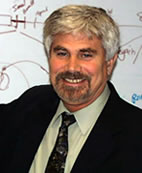 |
| Yoko Watanabe | |
| Yoko Watanabe graduated from Ochanomizu University (Tokyo), Faculty of Science in 1953. After completing her graduate course, she commenced research into the developmental biology of sponges at the Biology Laboratory of Ochanomizu University under Professor Matazo Kume. From 1974 to 1975, she studied sponge systematics at the Department of Zoology of the Napoli Zoological Station and the marine Biological Laboratory in Italy on a research fellowship from the Japan Society for the Promotion of science. She received her doctor of science from Tokyo University of Education for her studies of the development of oviparous demosponges in 1978. Her major research interests include gametogenesis, fertilization and development in the marine sponges Calcarea and Demospongiae and freshwater sponges. She retired from Ochanomizu University in 1996. Since 1998, she has been working as a guest researcher at the Zoological Department of the national Science Museum in Tokyo. In 1997, she received an award for Best Scientific Video from the Ministry of Science and technology for her work entitled “Life of the Freshwater Sponge. She also enjoys playing the koto, a Japanese stringed instrument, in her free time. |  |
| Judith Kimble | |
| Judith Kimble achieved her Ph. D. in 1978 from the University of Colorado in Molecular, Cellular and Developmental Biology. She then did postdoctoral studies in Cambridge, England at the MRC Laboratory of Molecular Biology, under the direction of Sir John Sulston. Dr. Kimble joined the faculty of the University of Wisconsin-Madison in 1983 as an Assistant Professor and is now a Full Professor. Her departmental affiliations include the Department of Biochemistry in the College of Agriculture and Life Science, the Department of Medical Genetics in the Medical School and the Laboratory of Molecular Biology in the Graduate School. She has been the recipient of a Romnes fellowship and a Mid-Career Award from UW-Madison, and is now a named Vilas Professor at the same institution. In 1994 Dr. Kimble was selected as a Senior Investigator of the Howard Hughes Medical Institute (HHMI). In 1995, Dr. Kimble was elected to the National Academy of Sciences and to the American Academy of Arts and Sciences. She was elected to the American Philosophical Society in 2002. Over her career, she has served as an editor for numerous journals and has served on a variety of scientific advisory panels within the United States and abroad. In 2000 she served as President of the Genetics Society of America. | 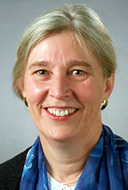 |
| Allan Spradling | |
| Dr. Spradling is Director of the Department of Embryology at the Carnegie Institution of Washington, Baltimore; Investigator with the Howard Hughes Medical Institute at the Carnegie Institution; Adjunct Professor of Biology at the Johns Hopkins University; and Adjunct Professor of Molecular Biology and Genetics at the Johns Hopkins University School of Medicine. He earned his B.A. degree in physics from the University of Chicago and his Ph.D. degree in cell biology from the Massachusetts Institute of Technology. His postdoctoral study was done at Indiana University with Anthony Mahowald. Dr. Spradling has been widely recognized for his research, is a member of the National Academy of Sciences and the American Academy of Arts and Sciences, and is also a fellow of the American Association for the Advancement of Science. Dr. Spradling and his lab members continue to develop new tools for Drosophila research through participation in the Drosophila genome project. Now that the genome has been fully sequenced, the current goal of the lab is to produce the key tools needed to understand gene function by isolating insertional mutations in all of the 13,600 genes that have been identified. | 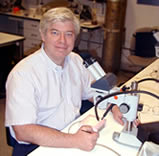 |
| Christopher Wylie | |
| Educated in Africa and then England. Attended University College London, and took faculty position there in 1970. Moved to St. George's Hospital Medical School, and then was elected to the F.J. Quick Chair of Biology at Cambridge University in 1989. Took the Martin Lenz Harrison Chair of Developmental Biology in 1994, and moved to Cincinnati Children's Hospital to become the William Schubert Professor, and Director of the Division of Developmental Biology, in 2000. The Division is growing rapidly, and now has a faculty of twenty developmental biologists. Research interests are in the cytoskeleton, early patterning of the vertebrate embryo, and the properties of germ line cells. Married to Janet Heasman (also my research partner). Four children: Matthew (24yrs), Sara (21yrs), Michael (20yrs), and Jake (17yrs). Founded the journal Development and held the position as Editor-in-chief from 1987 to 2002. Recreation: physically; tennis and golf, intellectually; music and theater. | 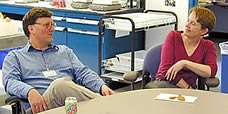 |
| Tony Hyman | |
| Tony Hyman
is group leader and director at the Max Planck Institute of Cell Biology
and Genetics in Dresden. He received his Ph. D. in Biology/Zoology from
Cambridge University / Kings College in 1988, before moving on to a postdoctoral
fellowship at the University of California at San Francisco. His lab seeks
the mechanisms by which microtubules perform a number of morphogenetic
processes, such as spindle assembly and membrane traffic, making use of
a wide range of genetic, biochemical, cell and molecular approaches in
three main model systems: the budding yeast S.cerevisiae, the African
clawed toad, Xenopus laevis, and the free-living nematode, Caenorhabditis
elegans. |
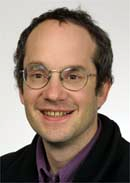 |
| Yuh Nung Jan | |
| Dr. Yuh Nung Jan is a Professor of Molecular Physiology at the University of California San Francisco, an Investigator of the Howard Hughes Medical Institute, and a member of the National Academy of Sciences. Early in his career he focused on neuronal function, performing some of the key studies on the role of neuropeptides in synaptic transmission and the cloning and functional characterization of voltage-gated ion channels. More recently he has made major contributions to our understanding of the development of the nervous system. He has used Drosophila genetics to identify key molecules controlling neuronal cell fate, to elucidate the cellular mechanisms underlying asymmetric cell division and inheritance, and to discover the molecular processes regulating the pattern of dendritic branching. |  |
| David Ish-Horowicz | |
| David Ish-Horowicz is head of the Cancer Research UK Developmental Genetics Laboratory at the CR-UK Lincoln's Inn Fields Laboratories in London, and studies the molecular mechanisms that regulate patterning of invertebrate and vertebrate embryos. He studied at the MRC Laboratory of Molecular Biology, Cambridge, and researched with Professor Walter Gehring in Basel, Switzerland, before establishing his own research group at the (then) Imperial Cancer Research Fund in London. His earlier work dealt mainly with the molecular genetics of Drosophila segmentation genes, with a particular interest in the pair-rule genes whose striped expression establish metameric (repeated) pattern. During this time, his lab identified the Hairy bHLH protein repressor and demonstrated that Hairy and related repressors act via the Groucho transcriptional corepressor. His group currently studies mechanisms of intracellular RNA localisation in Drosophila, using in vivo assays to characterise the RNA signals and motor machinery that underlie selective RNA transport. He also analyses segmentation in vertebrates, with an emphasis on the molecular oscillator ("segmentation clock") that appears to drive somitogenesis. His lab has identified transcriptional regulatory elements that drive cyclic transcription prior to segmentation, and is studying their regulation in order to understand the molecular basis of the clock. He is a member of the European Molecular Biology Organisation, an Honorary Research Professor of University College London, and a Fellow of the Royal Society. | 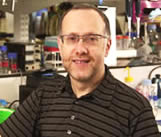 |
| Hiroshi Hamada | |
| Hiroshi
Hamada received his M.D. from Okayama University, Medical School in 1975,
and a Ph.D. from Okayama University, Graduate School in 1979. After 5
year as a post-doc in the NIH, he became an Assistant Professor at Memorial
University in Newfoundland, Canada, and started working on the regulation
of EC cell differentiation. Since 2002, Hiroshi has been a professor at
the Graduate School of Frontier Biosciences, Osaka University. His research
interests have focused on the genetic dissection of mouse embryogenesis.
In particular, his current interests include 1) early embryonic patterning
events such as anteroposterior patterning and left-right patterning, 2)
regulation of organogenesis by retinoic acid, and 3) maintenance of pluripotency.
His major achievements are 1) establishment of enhancer-trap method with
cultured cells, 2) identification of Oct3/4, a transcription factor required
for maintaining pluripotency, 3) dissection of genetic pathway for left-right
patterning. |
|
| Edward M. De Robertis | |
| Edward M. De Robertis grew up in Montevideo, Uruguay where he received his M.D. degree in 1971. After completing a Ph.D. in Chemistry with H. N. Torres in Argentina, he trained in Xenopus embryology under John B. Gurdon in Cambridge, England. His work in developmental biology has contributed to the realization that antero-posterior and dorso-ventral patterning genes have been conserved throughout animal evolution. His work on Chordin, a secreted antagonist of ventral BMP signals that is regulated by proteolytic cleavage, has provided a new paradigm for intracellular signaling. He joined the UCLA School of Medicine in 1985, where he is the N. Sprague Professor of Biological Chemistry and Investigator of the Howard Hughes Medical Institute. He is a member of the European and Iberoamerican Molecular Biology Organizations, of the American Academy of Arts and Sciences, and of the Latin American Academy of Sciences. Dr. De Robertis serves as President of the International Society of Developmental Biologists (ISDB). | 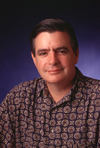 |
| Olivier Pourquie | |
| Dr. Olivier Pourquie received his PhD from the National Institute for Agronomy in France and his advanced training in Developmental Biology from Nicole Le Douarin at the Institute d'Embryologie du College de France at Nogent sur Marne. He was a group leader at the Developmental Biology Institute of Marseille (France) for six years and in 2002 he relocated his lab to the Stowers Institute for Medical Research in Kansas City (USA).
Pourquie is widely recognized as an international scholar of Vertebrate Developmental Biology. He is known for the discovery of a molecular oscillator, called the Segmentation Clock, involved in the metamerization of the vertebrate body axis. He is a member of the European Molecular Biology Organization and until this year was president of the French Society for Developmental Biology. Pourquie's research is aimed at understanding the molecular basis of vertebrate body axis segmentation and patterning during Development. His work has relied heavily on the use of the chick embryo as a model system, but it also largely involves mouse genetics. |
 |
| Elaine Fuchs | |
| Dr. Elaine Fuchs received her B.A. in Chemistry from the University of Illinois, her PhD in Biochemistry from Princeton University and her advanced training in skin biology from Howard Green at MIT. She was a Professor at the University of Chicago for 20 years, before relocating her laboratory to Rockefeller University in New York City in 2002. Fuchs is widely recognized as an international scholar of skin biology. She is known for her unconventional use of "reverse genetics" in her research, where she typically begins with a protein and works her way to the underlying basis of a human genetic disorder. She is a member of the National Academy of Sciences (NAS), the Institute of Medicine, and the American Academy of Arts and Sciences. In the past year, she has been the President of the American Society of Cell Biology, the recipient of the Richard Lounsbery Award by the NAS, and elected to the Council of the NAS. Fuchs' research focuses on understanding the molecular mechanisms underlying development and differentiation of the mammalian skin epidermis and its appendages, and how these processes go awry in various human diseases of the skin, including genetic diseases and skin cancer. She utilizes mammalian stem cell cultures and gene-knockout technology as model systems. |
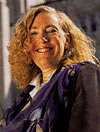 |
| Peter Mombaerts | |
| Peter Mombaerts received his M.D. from the Catholic University of Leuven in 1987, and his Ph. D. from the M.I.T. Department of Biology in 1992 for studies on lymphocyte development and function with mutant mice created by gene targeting. His current work focuses on axon guidance in the olfactory system. | 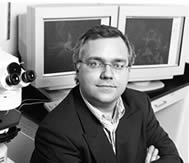 |
| Christine E. Holt | |
| Christine E. Holt received her B.Sc.Hons degree in Biological Sciences from Sussex Unversity and her PhD. in Zoology from the Biophysics Department, Kings College London University (1982). She did her postdoctoral studies in the Department of Biology, University of California San Diego and in the Department of Physiology, Oxford University. In 1986/87 she was a Visiting Alexander von Humboldt Fellow at the Max-Planck-Institut fur Entwickslungbiologie, Tubingen, Germany, and in 1993/94 a visiting scholar at the Wellcome CRC Institute, Cambridge, UK. She was an Assistant/Associate Professor in the Department of Biology, University of California San Diego (1989-1997) and in 1997 she moved to the Department of Anatomy, University of Cambridge where she is currently a Reader in Developmental Neurobiology. She was a recipient of a McKnight Scholars Award for Neurosciences (1986) and a Pew Scholars Award in Biomedical Sciences (1991). She is married to Bill Harris, her long-time collaborator, and has two children. She is an editor for the Journal of Neurobiology and the Journal of Neuroscience. Her research on the development of the visual system focuses on cell fate decisions in the retina and axon guidance. | 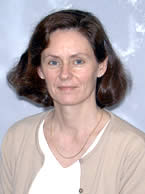 |
| Hajime Fujisawa | |
| My scientific interest is focused on cellular and molecular mechanisms that guide axons with a high degree of precision to establish fairly stereotyped neuronal connections. From the end of 1970th to the beginning of 1980th, I performed anatomical studies on amphibian and avian retinotectal projection system. I labeled retinal axons with neuronal tracers, and showed how individual developing and regenerating axons from different parts of the retina recognize discrete regions within the tectum to give raise to a fairly organized retinotopic neuronal connection. I then started the screening of molecules that would be involved in the establishment of the retinotectal projection in Xenopus tadpoles, by hybridoma techniques, and identified two molecules named as neuropilin and plexin. Nowadays, 2 neuropilins and more than 10 plexins have been identified in various animal species and assumed to serve as receptors for semaphorins, a large family of axon guidance molecules with repulsive and attractive nature. Currently, my works are focused on how semaphorins and their receptors regulate axon guidance and neuron network formation in vivo. | 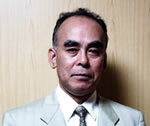 |
|
|
|
| Mu-ming Poo | |
| Mu-ming Poo is currently the Class of 1933 Professor and Head of Division of Neurobiology at University of California, Berkeley. Poo was born in China, received his B.S. degree in physics from Tsinghua University in Taiwan in 1970, and his Ph.D. in biophysics from Johns Hopkins University in 1974. After two years of postdoctoral research at Marine Biological Laboratory, Woods Hole, and Purdue University, he joined the faculty of University of California at Irvine in 1976. Since 1985, he has held faculty appointments at Yale University, Columbia University, and University of California at San Diego before assuming his current position at U.C. Berkeley. His research interests have covered many areas of developmental neurobiology, including axon guidance, synaptogenesis, and synaptic plasticity. In recent years, he has made important contributions in our understanding of signal transduction mechanisms underlying axon guidance and the role of electrical activity and neurotrophic factors in regulating synaptic functions and the assembly of neural circuits. For his work on axon guidance, he was awarded the Ameritec Prize for Paralysis Research in 2001. He is currently a member of the editorial board of Neuron and Journal of Neuroscience. | 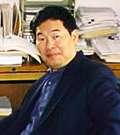 |
|
|
||